 |
| May 12, 2020 | Volume 16 Issue 18 |
Designfax weekly eMagazine
Archives
Partners
Manufacturing Center
Product Spotlight
Modern Applications News
Metalworking Ideas For
Today's Job Shops
Tooling and Production
Strategies for large
metalworking plants
Moon buggy wheel tech evolves for Mars mission
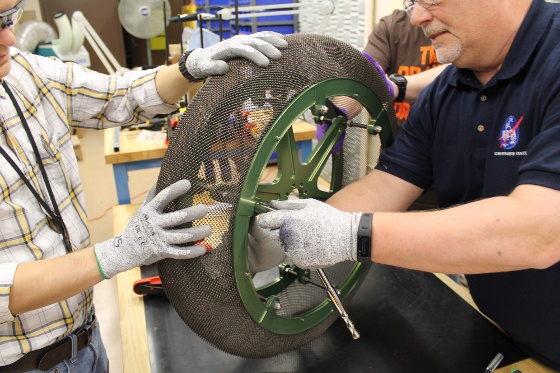
Engineers at NASA's Glenn Research Center assemble a new shape memory alloy rover tire prior to testing in the Simulated Lunar Operations Laboratory. [Credit: NASA]
The wheels from the lunar roving vehicle (LRV) for the Apollo 15, 16, and 17 moon missions were made of steel piano wire and titanium treads to give them a cushioning, non-rigid structure. Now NASA has taken that technology a big step further, using shape memory alloys to create tires for Mars rovers.
By Jimi Russell, NASA Glenn Research Center
It's rocky. It's sandy. It's flat. It's cratered. It's cold. The surface of Mars is a challenging and inhospitable place, especially for rovers. As future missions to Mars become more complex, NASA's robotic wanderers will need new technologies to look deeper into the history of the Red Planet.
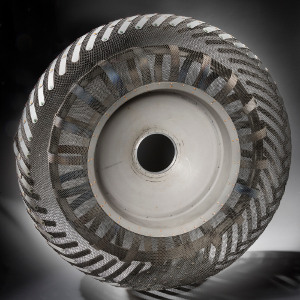
New design inspiration? This spare wheel from the lunar roving vehicle (LRV) for the Apollo 15, 16, and 17 moon missions was made of steel piano wire and titanium treads to give it a cushioning, non-rigid structure. [Image courtesy: Smithsonian National Air and Space Museum]
One of those technologies is a new tire in development at NASA's Glenn Research Center using innovative shape memory alloys (SMA).
Tires made from these shape-shifting materials offer unmatched durability because they flex with the terrain, unlike current rigid wheels. They can actually envelop rocks without the risk of puncture, and they can be designed to provide a smoother ride -- almost like adding shock absorbers -- to minimize potential damage to systems on the rover.
"Glenn began working with the U.S. tire industry years ago to develop a better non-pneumatic, or airless, tire for the Moon," said Vivake Asnani, lead tire engineer at Glenn. "This led to an advanced tire known as the Spring Tire, constructed using a network of steel springs, that adapted and contoured to terrain like a traditional rubber tire."
Glenn engineers have since replaced the conventional steel with springs made of SMA to improve a rover's ability to operate in extremely rocky terrain and at the cold temperatures of Mars. This is appealing to mission planners for future use on Mars because of its lighter weight, traction performance, and durability.
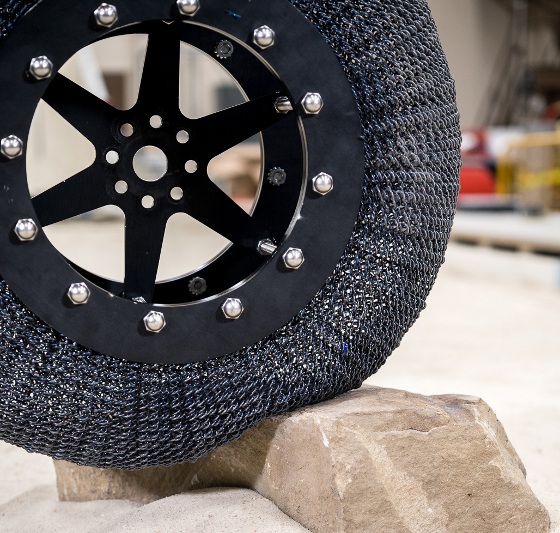
This is one recent SMA tire version that has dense coils, weighs about 20 lb, and can handle 165 lb of load. [Credit: NASA]
Engineers are now refining SMA materials processing, working designs, and completing environmental testing on a new Mars tire at Glenn's Simulated Lunar Operations Lab.
"We're developing a Mars-grade material that greatly improves SMA capability and makes reversible material deformations possible in the harsh Martian environment without sacrificing performance," said Dr. Santo Padula, lead SMA materials and design engineer at Glenn.
Testing has proven the tire's superior grip meets or exceeds all traction performance demands and will give rover drivers the ability to cross varying terrains. The more capable tires also allow for a rover design using four tires as opposed to the past six-tire configurations. So, in the case of future human exploration or robotic missions, these tires can provide valuable flexibility in the vehicle and spacecraft design.
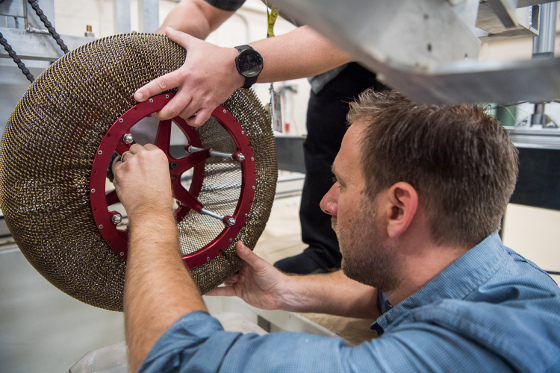
Engineer Colin Creager attaches the latest version of the SMA Spring Tire to a test rig in the SLOPE lab. This version weighs 15 lb, can carry double the amount of load as the previous version, and performs better in the deep-space temperatures. [Credit: NASA]
The next of NASA's Mars exploration missions, Mars 2020 and its Perseverance rover, is scheduled to launch in July.
Meanwhile, engineers at Glenn will continue to mature SMA technologies for applications on Mars and here on Earth, including passenger vehicle, military, and aircraft tires. A concept SMA passenger tire has been tested, and could eventually replace conventional air-filled tires. This could eliminate the risk of punctures and driving on under-inflated tires, while improving fuel efficiency and safety.
------------------------------
Designfax addition
SIDEBAR 1: More on the SMA tech: What does it do?
Dr. Padula said in an interview posted on the NASA site, "Shape Memory Alloy (SMA) materials are a new class of metals that are energetically different than conventional metallic compounds. This energetic difference gives them a unique deformation mode -- what is referred to as a transient 'twinning' process.
"Thus, these materials undergo a solid-state phase transformation that allows us to manipulate the atomic structure of the metal merely by manipulating the way that we either mechanically load or thermally load the material.
VIDEO: Dr. Padula explains why nickel titanium, a shape memory alloy with impressive capabilities, is a game-changing material that dramatically advances the development of spring tires.
"Depending on the way the material is initially fabricated, it's possible to use mechanical loading and unloading or heating and cooling to create large deformations that are fully recoverable. This opens a new paradigm in design, whereby large shape changes in the component can be achieved and used to reshape the way we think about design."
What is most exciting about this technology?
"The automotive sector is already using these materials," said Dr. Padula. "In fact, almost every lumbar support system in vehicles now is actually SMA-driven, usually using SMA wires as the actuation component. At NASA, we are developing new adaptive technologies for large-scale aircraft in the aeronautics world in order to replace flap elements and control surfaces on wings with more lightweight, compact, and efficient systems. These materials work for pretty much anything that is actuation-based."
"Shape memory alloys have been heavily used for decades in the biomedical field -- everything from catheter tubes to arterial stents," added Dr. Padula. "We also have recently developed a new, non-pneumatic tire technology that is needed for improving the performance and durability of our space rover applications. A version of this technology has also been demonstrated on a commercial Jeep vehicle where it performed exceptionally. Hence, these unique materials look extremely promising in revolutionizing the entire terrestrial tire industry, and that's just the tip of the iceberg."
------------------------------
SIDEBAR 2: Problems with current Mars rover wheels
NASA's Mars Curiosity rover has six wheels made of aluminum. In spring 2017, it was announced that a routine check of its wheels found two small breaks on the rover's left middle wheel -- more signs of wear and tear as the rover approached its five-year anniversary and its 10-mile mark of travel.
The mission's first and second breaks in raised treads, called grousers, appeared in a March 19, 2017, image check of the wheels, documenting that these breaks occurred after the last check on Jan. 27.
The monitoring of wheel damage on Curiosity, plus a program of wheel-longevity testing on Earth, was initiated after dents and holes in the wheels were seen to be accumulating faster than anticipated all the way back in 2013.
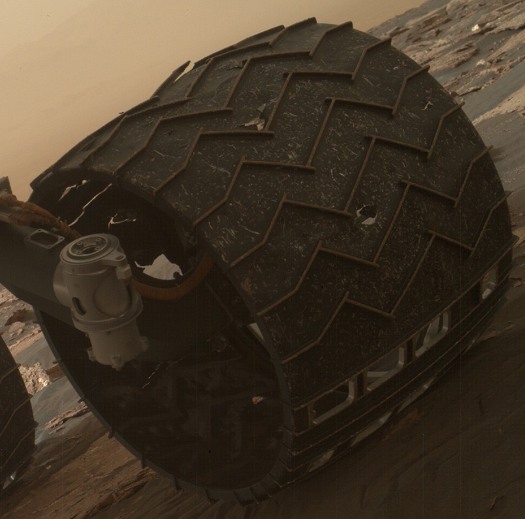
Detail view of the 2017 wear damage. [Credits: NASA/JPL-Caltech/MSSS]
Each of Curiosity's six wheels is about 20 in. (50 cm) in diameter and 16 in. (40 cm) wide, milled out of solid aluminum. The wheels contact ground with a skin that's about half as thick as a U.S. dime, except at thicker treads. The grousers are 19 zigzag-shaped treads that extend about a quarter inch (three-fourths of a centimeter) outward from the skin of each wheel. The grousers bear much of the rover's weight and provide most of the traction and ability to traverse over uneven terrain.
At the time, Matt Heverly, mobility systems engineer for the Mars Science Laboratory rover at NASA's Jet Propulsion Laboratory (JPL), told Designfax exclusively in a phone interview that the conditions encountered on Mars by the rover and the way the rover responded to them -- including wind-sharpened exposed rocks called "ventifacts" -- were not adequately tested on Earth.
That testing often takes place in the Mars Yard, a physical test facility at JPL that features a simulated Martian landscape. There, a "Scarecrow" rover is run through challenges both imagined and encountered. Scarecrow is a full-size, stripped-down test vehicle that is 3/8 the mass of the real Curiosity to help simulate how the vehicle will act under the gravitational conditions of the red planet.
In the Mars Yard, "We put many very sharp rocks, fractured rocks, and we drove over them at great distances without any problems, but fundamentally the thing we did not do was embed those sharpest of rocks into cement or into an immovable portion of the ground," Heverly said.
When the Scarecrow rover encountered rocks in the Mars Yard that had been buried as part of testing, the rover was so powerful that it simply pushed them out of the way. On Mars, some of the rocks are truly not movable, and if they are of the ventifact variety, they are sometimes particularly dangerous for the Curiosity rover's aluminum wheels. "So when they are encountered on Mars, the force between the wheels and the rocks is much greater than simply the weight of the vehicle on the rocks," said Heverly. "The thrust forces generated by the other wheels pushing that wheel into those embedded sharp rocks created very concentrated points of stress in the wheels, which resulted in failure of the skin of the wheels."
"We did expect some damage," said Heverly, but "the rate of damage accumulation was much faster than we expected."
Nonetheless, Curiosity soldiers on. The damage has not affected fundamental performance yet.
New wheel designs, like the springy, open-air shape memory alloy wheels being perfected at NASA now, may prove a more hardy option on rovers that explore Mars in the future.
Back on Mars, the Curiosity rover is still operational. As of May 8, 2020, it has been on Mars for 2,757 sols (2,832 total days) since landing on August 6, 2012. It has driven about 13.73 miles.
Source: NASA, NASA JPL, NASA Glenn Research Center
Published May 2020
Rate this article
View our terms of use and privacy policy
